Scale insects, tiny plant parasites with over 8000 known species, are a common adversary for houseplant enthusiasts. These insects belong to the superfamily Coccoidea and are found worldwide, posing a significant threat to the health of indoor plants. They are known to feed on plant sap, causing a plethora of damaging effects ranging from stunted growth to eventual plant death.
A report from the Journal of Economic Entomology elucidates their lifecycle, from the highly mobile ‘crawler’ stage to the sedentary, sap-sucking adult stage that develops a protective waxy shell, resembling a fish scale. Particularly resilient, these insects have evolved to thrive in indoor environments, enjoying the safety of our homes devoid of natural predators.
In this comprehensive guide, we will unravel the enigma of scale insects, discussing their biology, the damage they cause, and more importantly, how to effectively manage and prevent an infestation. Equipped with this knowledge, you’ll be able to safeguard your indoor garden against these persistent pests.
What are Scale Insects?
Scale insects are tiny, sap-sucking pests that can cause severe damage to houseplants. They are often mistaken for plant growths due to their small size and the hard, shell-like covering that protects them. These insects come in various colors, shapes, and sizes, but most often appear as small, brown, rounded lumps on your plant’s leaves and stems.
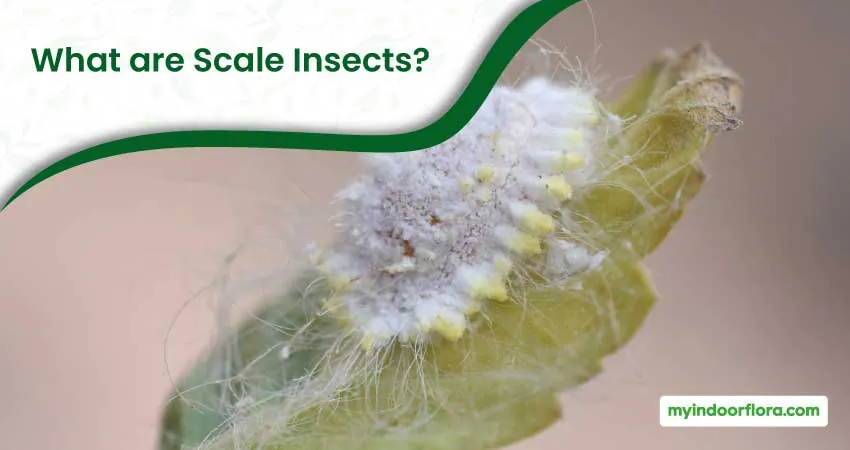
Among the multitude of scale insect species, two types are commonly found on houseplants. These are:
- Armored Scales (Diaspididae): They form a hard, detachable cover over their bodies and are typically smaller in size. A common example is the San Jose scale.
- Soft Scales (Coccidae): They produce a soft, waxy layer that is part of their body. They also excrete honeydew, a sugary substance that can lead to the growth of sooty mold. Brown soft scale is a frequent offender among houseplants.
Identifying Scale Insects
Identifying scale insects can be a challenge due to their small size and their ability to blend in with the plant’s natural color and texture. They can be round, oval, or oyster shell-shaped, predominantly brown in color but can range from white to black.
Scale insects are often found on the stems and leaf joints of an infested houseplant, and along the veins of the leaves. They can also be found on the underside of leaves, making them even harder to spot.
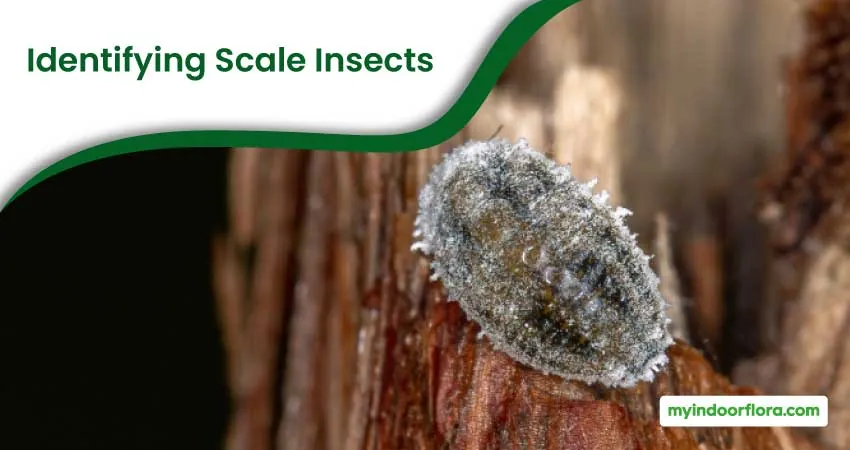
One tell-tale sign of a scale infestation is the presence of a sticky residue on the leaves, pots, or surrounding area of the plant. This residue is excreted by the insects as they feed, and can often attract other pests such as ants.
Life Cycle of Scale Insects and Their Impact on Houseplants
The life cycle of scale insects is a complex process that involves several stages. Understanding these stages can help in devising effective strategies for their control.
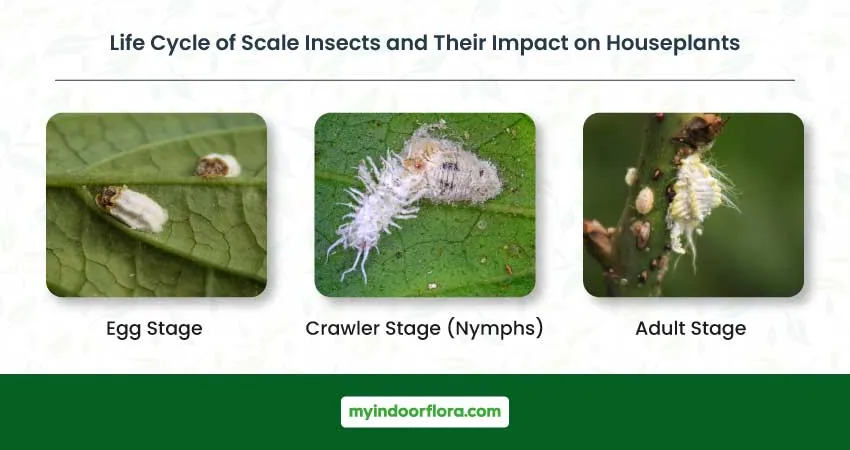
1. Egg Stage
- Description: The life cycle begins when the female scale insect lays her eggs underneath her protective shell. The number of eggs laid can vary greatly depending on the species, but it can be anywhere from a few dozen to a few hundred.
- Impact on Houseplants: At this stage, the scale insects pose no direct harm to the houseplants as they are not yet feeding on the plant’s sap. However, the presence of eggs indicates a potential future infestation.
- Treatment: Treating scale insects at the egg stage can be challenging due to the protective shell of the female. However, insecticidal soaps and oils can be effective if they are able to penetrate the shell.
2. Crawler Stage (Nymphs)
- Description: Once the eggs hatch, the young scale insects, known as crawlers, emerge. These crawlers are mobile and will move around the plant in search of a suitable feeding site. This is the only stage in the life cycle where the scale insects are mobile.
- Impact on Houseplants: The crawlers will begin feeding on the plant’s sap once they find a suitable site. This can lead to yellowing of leaves, stunted growth, and in severe cases, death of the plant.
- Treatment: The crawler stage is the most vulnerable stage in the life cycle of scale insects and the best time to implement control measures. The crawlers do not yet have their protective shell, making them susceptible to treatments such as insecticidal soaps and oils.
3. Adult Stage
- Description: After finding a suitable feeding site, the crawlers will settle down and begin to form their protective shell. Once this shell is fully formed, the scale insects become immobile and will remain in the same spot for the rest of their lives. The adult stage is where the scale insects reach their full size and the females begin laying eggs to start the next generation.
- Impact on Houseplants: Adult scale insects continue to feed on the plant’s sap, leading to the same symptoms as seen in the crawler stage. However, the damage can be more severe due to the larger size and increased feeding of the adults.
- Treatment: Adult scale insects can be difficult to control due to their protective shell. However, treatments such as rubbing alcohol can be effective in killing the adults. The alcohol needs to come in direct contact with the scale insects, so thorough application is necessary.
Understanding the life cycle of scale insects is crucial for effective treatment. Each stage presents its own challenges and requires different strategies for control. However, with persistence and regular treatment, it is possible to control scale insect infestations and keep your houseplants healthy.
Damage Caused by Scale Insects
Scale insects, though small in size, can cause significant damage to houseplants. Their feeding habits and rapid reproduction can lead to a variety of issues that can affect the overall health and appearance of your plants.
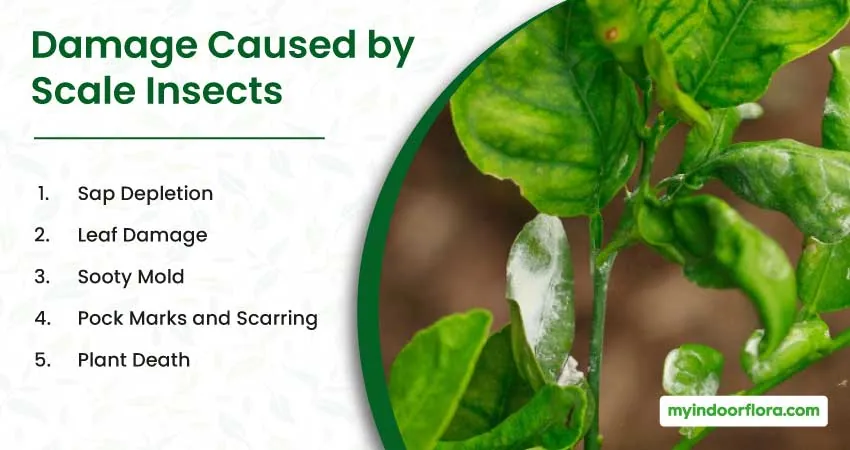
1. Sap Depletion
- Description: Scale insects feed on the sap of plants. This sap, which is crucial for the plant’s nutrition, is sucked out by the insects, leading to a depletion of vital nutrients.
- Impact on Houseplants: The loss of sap can cause the plant to become weak and malnourished. This can lead to stunted growth and a general decline in the health of the plant. In severe cases, the plant may become so weak that it cannot sustain its own weight, leading to drooping stems and leaves.
2. Leaf Damage
- Description: As scale insects feed, they can cause visible damage to the leaves of the plant. This damage often appears as yellow spots or patches on the leaves where the insects have been feeding.
- Impact on Houseplants: The damage to the leaves can affect the plant’s ability to photosynthesize effectively, leading to further weakening of the plant. In severe infestations, the leaves may drop off entirely.
3. Sooty Mold
- Description: Scale insects excrete a sticky substance known as honeydew. This honeydew can attract a type of fungus known as sooty mold.
- Impact on Houseplants: Sooty mold, as the name suggests, appears as a black, soot-like coating on the leaves of the plant. While it does not directly harm the plant, it can block sunlight, hindering the plant’s ability to photosynthesize. This can lead to further weakening of the plant.
4. Pock Marks and Scarring
- Description: The feeding activity of scale insects can lead to the formation of pock marks or scars on the leaves and stems of the plant.
- Impact on Houseplants: These marks and scars can be unsightly, affecting the aesthetic value of the plant. They can also serve as entry points for other pests or diseases.
5. Plant Death
- Description: In severe infestations, the combined effects of sap depletion, leaf damage, sooty mold, and scarring can lead to the death of the plant.
- Impact on Houseplants: The death of a plant due to a scale insect infestation is a clear indication of the severity of the problem. It underscores the importance of early detection and treatment of scale insects to prevent such outcomes.
The damage caused by scale insects can be extensive, affecting not only the health but also the appearance of your houseplants. However, with early detection and appropriate treatment, it is possible to control scale insect infestations and limit the damage they cause.
Why Are Scale Insects Attracted to Your Houseplants?
Not all houseplants get infested with scale insects. Some factors increase the likeliness of an infestation.
Scale insects are attracted to plants that are stressed due to improper care, such as inconsistent watering, inappropriate light levels, or nutrient deficiencies. They are also drawn to plants with new growth, where tissues are tender and easier to pierce.
Maintaining the right indoor environment can play a pivotal role in preventing an outbreak. High humidity levels, lack of natural predators, and overcrowding of plants can create a perfect breeding ground for these pests.
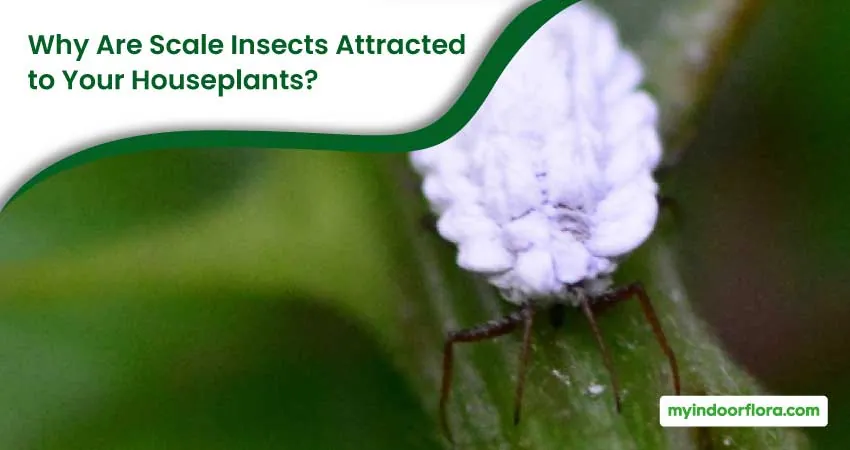
Nutrient-rich plants are like a buffet for scale insects. Over-fertilization, especially with nitrogen-rich fertilizers, can make your plants more attractive to these pests. Conversely, plants with a balanced diet are less likely to suffer from severe infestations.
Are Certain Houseplants More Susceptible to Scale Insects?
While scale insects aren’t particularly picky, some houseplants are more susceptible to their attack.
Certain plants like ferns, ivy, and orchids seem to attract more than their fair share of scale insects. Succulents, citrus plants, and ficus are also commonly infested. Be extra vigilant if you have these species in your houseplant collection.
Taking care of susceptible plants involves regular inspection and providing optimal care conditions. These plants may benefit from more frequent checks and prompt removal of any visible pests.
How to Detect Scale Insects in Your Houseplants Early?
Early detection of scale insects is crucial in managing the infestation effectively. Regular inspection and knowledge of key indicators can be your first line of defense.
Key Visual Indicators of Scale Insect Presence
Some tell-tale signs of scale infestation include:
- Presence of tiny, immobile bumps on leaves, stems, or plant bases.
- Sticky honeydew and subsequent sooty mold growth.
- Withered or yellowing leaves, especially if it’s not due to usual plant shedding.
Regular Inspection Techniques for Early Detection
Implement a routine plant check-up to spot any irregularities early on. Make sure to examine the undersides of leaves and the junctions between leaves and stems—popular hangouts for scale insects.
Importance of Early Detection in Effective Control
The earlier the infestation is detected, the easier it is to control. Scale insects in the crawler stage are more vulnerable to treatments, while those under the waxy shell are harder to eradicate. Therefore, timing is of the essence in winning the battle against these pests.
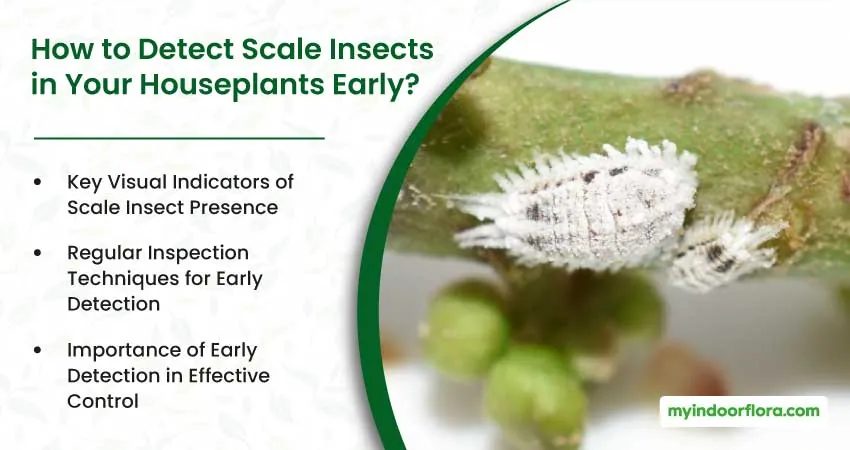
Methods to Get Rid of Scale Insects
There are several effective methods for treating scale insect infestations on houseplants. These methods are organic and safe for both your plants and your household.
Manual Removal
One of the simplest methods to start treating a scale infestation is manual removal. This can be done using a cotton swab dipped in rubbing alcohol. The alcohol helps to loosen the scale insects from the plant, making them easier to remove.
For stubborn scale insects, you may need to use a soft toothbrush or even your fingernail to gently pry them off the plant. Be sure to check all areas of the plant, including the undersides of leaves and the base of the stem.
Homemade Insecticidal Soap
A homemade insecticidal soap can be an effective treatment for scale insects. To make this soap, mix 1 teaspoon of mild liquid soap with 1 liter of water. Spray this solution directly onto the scale insects and the leaves of your infested plant.
The soap helps to break down the protective shell of the scale insects, making them more susceptible to other treatments. However, some types of soap can damage plants, so it’s best to test this solution on a small area of the plant first.
Neem Oil Treatment
Neem oil is a natural insecticide that is effective in treating scale infestations. It works by disrupting the life cycle of the insects, making it harder for them to grow and reproduce.
To use neem oil, mix it with a little bit of mild liquid soap to help the oil mix with water. Then, spray the solution onto the entire plant, making sure to cover all areas where scale insects may be hiding.
Use of Natural Predators
If you have a severe infestation, consider introducing natural predators. Beneficial insects like ladybugs, lacewings, and parasitic wasps feed on scale insects and can help bring the infestation under control.
The Role of Household Remedies
Household remedies, including a solution of vinegar and water or a mix of dish soap and water, can be sprayed on the plants to deter scale insects. However, it’s important to test a small area first, as some plants can be sensitive to these treatments.
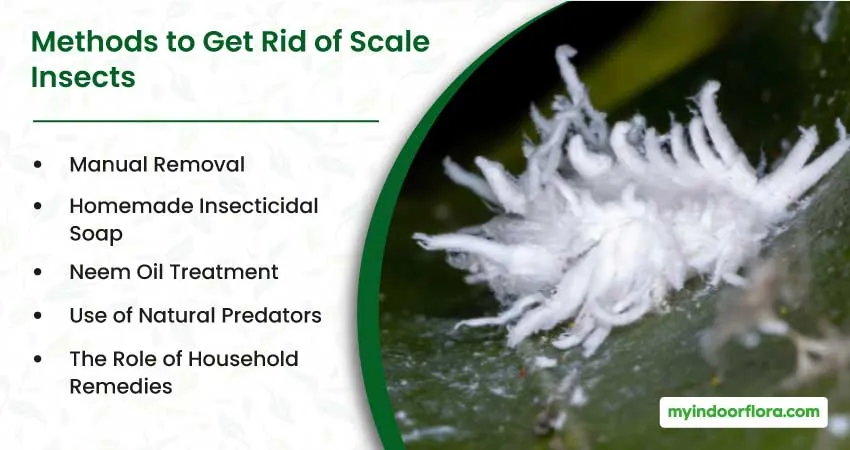
How to Use Chemical Treatments Safely and Effectively?
Sometimes, a heavy infestation necessitates the use of chemical treatments. While effective, they should be used judiciously and safely to protect both your plants and your household.
When to Consider Chemical Treatments
Chemical treatments should be your last resort when non-chemical methods have failed to control the infestation. It’s also crucial to use them when the infestation is widespread, affecting multiple plants in your indoor garden.
Choosing the Right Insecticide for Scale Insects
Several insecticides are effective against scale insects. These include horticultural oils, insecticidal soaps, and systemic insecticides. Choose a product labeled for use against scale insects and always follow the product instructions for application rates and timing.
Proper Application Techniques to Ensure Safety and Effectiveness
While applying chemical treatments, ensure safety for yourself and your household. Wear protective gear, like gloves and a mask. Spray in a well-ventilated area, or better yet, outdoors if possible. Always follow label instructions for dosage and application frequency, and keep all pesticides out of the reach of children and pets. Remember, the key to effective control is thorough coverage since the product needs to contact the insect to work.
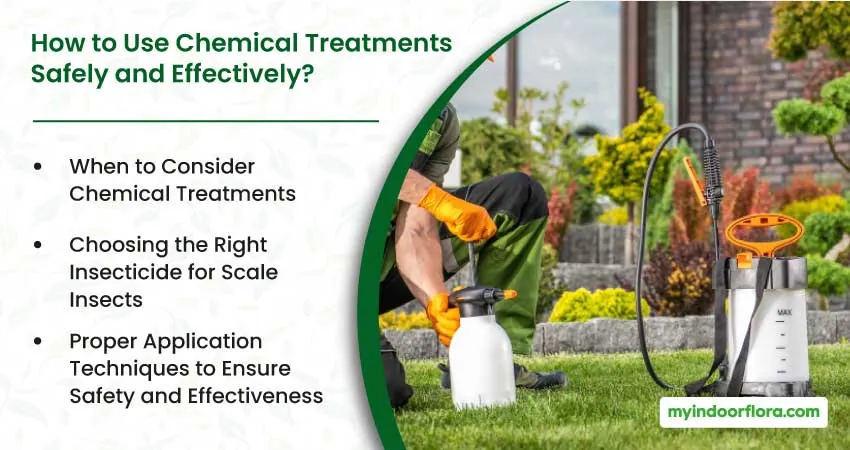
Preventive Measures
Prevention is always better than cure, and this is especially true when it comes to scale insects. Regular inspection of your houseplants can help you spot an infestation early, making it easier to treat.
- Healthy plants are more likely to withstand pest attacks. Regular watering, appropriate fertilization, and ensuring your plants receive adequate light can enhance their resilience. Pruning dead or heavily infested plant parts also helps in managing scale populations.
- Replacing the top layer of soil can also help prevent scale infestations, as scale insects can sometimes hide in the soil. Additionally, cleaning the surrounding area and sterilizing pots before reusing them can help eliminate any remaining scale insects.
- Routine inspections can help you spot and manage an infestation in its early stages. Check your plants for signs of scales, especially during their active growth phase. Cleaning dust off the leaves can also help deter pests.
- New plants could bring in unwanted pests. Quarantining new additions and thoroughly inspecting them for signs of scale insects before introducing them to your plant collection can prevent potential infestations.
Conclusion
Scale insects can be a serious problem for houseplants, but with the right knowledge and tools, you can effectively treat and prevent these pests. Remember, the key to successful treatment is persistence and regular inspection of your plants. With these strategies, you can keep your houseplants healthy and free from scale insects.
